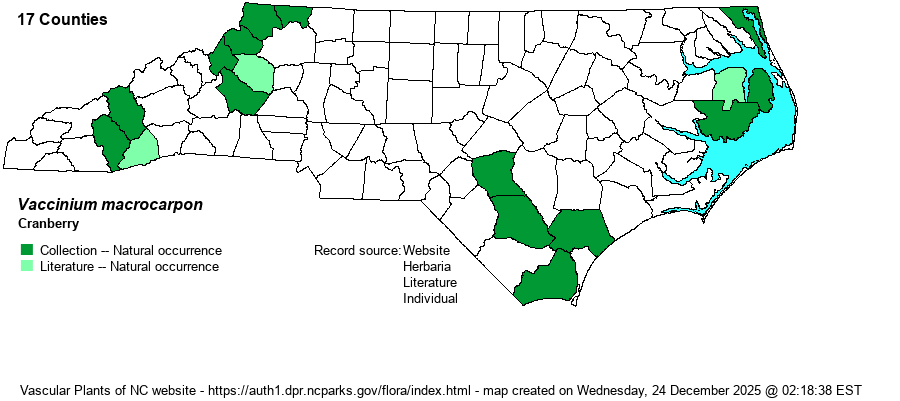| Author | Aiton | |
| Distribution | A trimodal distribution in the state, being found in the Mountains, Sandhills (rare), and the lower Coastal Plain. It is very spottily distributed in these regions, especially in the Coastal Plain, where disjunct between counties on the Pamlimarle Peninsula and Brunswick and Bladen counties. A 1977 Carteret County specimen (Marcus 46 NCU) is actually V. crassifolium.
This is a Northern species, ranging across much of Canada, and south through NJ and PA, and then mainly in the Appalachians only to southern NC and southern TN (not in SC or GA). There are scattered coastal populations in MD, DE, VA, and NC.
| |
| Abundance | Rare and quite local, though may occur in dense stands where found. Many more occurrences in the Mountains than in the Coastal Plain. It is State listed as Threatened. | |
| Habitat | The species strictly occurs in bogs in the Mountains. In the lower Coastal Plain, it is mainly restricted to the interior of pocosins, where vegetation is very low and the soil is peaty. It may occur in a few similar acidic wet places such as ditches, but usually in or adjacent to pocosins, always where there is peat soil. In the Sandhills it occurs in a small number of boggy scrapes on terraces of Little River. |
| Phenology | Blooms from May to July, and fruits from August to November. | |
| Identification | This is the familiar cranberry of Northern bogs, with surprisingly large red berries for the size of this tiny plant. It is a trailing evergreen shrub that grows vine-like but has mostly erect but very short branches a few inches long. The tiny leaves only reach 1/3-inch long and are quite narrow, with revolute margins. In the mountains, there is no plant even remotely similar to it, but in the Coastal Plain it could be confused with Vaccinium crassifolium. However, this latter species has wider leaves and does not grow in such wet and peaty soils as pocosin openings. When in flower, no other NC species has the tiny pale pink to white, strongly recurved petals, with long exerted stamens, that this species shows. Because it is so small, even though it can grow in large colonies, it may be overlooked during a casual search for it, and it may take the flowers or fruits to catch the eye of the observer. | |
| Taxonomic Comments | None
| |
| Other Common Name(s) | Large Cranberry, American Cranberry. Because there is another small stature cranberry in North America – V. oxycoccos, named as Small Cranberry, it seems that the best common name for V. macrocarpon ought to be Large Cranberry, to avoid confusion. | |
| State Rank | S2 | |
| Global Rank | G5 | |
| State Status | T | |
| US Status | | |
| USACE-agcp | OBL link |
| USACE-emp | OBL link |

